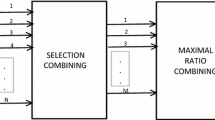Abstract
This paper considers the Alamouti’s two-branch transmit diversity scheme. This scheme supports a maximum likelihood detection based on linear processing at the receiver. When no knowledge of the channel is available — at the transmitter and the receiver- the above scheme requires in general the estimation of the two discrete propagation channels seen from the two transmit antennas. Our objective is to evaluate the Alamouti’s technique of diversity with a realistic estimation algorithm considering a very fast time-varying channel. For a robust channel estimation, we propose an EM-based maximuma posteriori semi-blind algorithm. This algorithm requires a convenient representation of the time-varying fading channel using a discrete version of the Karhunen-Loève expansion theorem. The iterative receiver optimally uses pilot as well as unknown data symbols for improving channel estimation quality. The validity of the proposed algorithm is highlighted by simulation results. Moreover, a complexity evaluation of this algorithm and a comparison is provided for different scenarii.
Résumé
Cet article considère le schéma de diversité spatio-temporelle à deux antennes à l’émission proposé par Alamouti. Ce schéma effectue une détection au maximum de vraisemblance basée sur un traitement linéaire au niveau du récepteur. Quand le canal n’est pas connu — à l’émetteur et au récepteur — ce schéma suppose une estimation des deux canaux de propagation vus par les deux antennes d’émission. Notre objectif est d’évaluer cette technique de diversité avec une estimation réaliste considérant un canal variant très rapidement dans le temps. Pour une estimation robuste du canal, nous proposons un algorithme, bloc par bloc, d’estimation au maximuma posteriori. Ce dernier effectue une estimation itérative semi-aveugle du canal basée sur l’algorithme EM de maximisation d’espérance. Il nécessite une représentation convenable du canal variable dans le temps en se servant du théorème de développement orthogonal de Karhunen-Loeve. Le récepteur itératif, utilise de manière optimale les symboles pilotes et les symboles inconnus de données pour améliorer la qualité de l’estimation du canal. L’intérêt de l’algorithme utilisé est illustré par des résultats de simulations. De plus, une évaluation de la complexité de cet algorithme avec comparaison est fournie pour différents scénarios.
Similar content being viewed by others
References
Alamouti (S.M.). A simple transmit diversity technique for wireless communications.IEEE Journal of Selected Areas on Communications.16, October 1998, pp. 1451–1458.
Wittnebeen (A.). A new bandwidth efficient transmit antenna modulation diversity scheme for linear digital modulation.Proceedings of the 1993 IEEE International Conference on Communications (ICC’93). May 1993, pp. 1630–1634.
Tarokh (V.),Seshadri (N.),Calderbank (A.R). Space-time codes for high data rate wireless communications: Performance criteria and code construction.IEEE Transactions on Information Theory, March 1998.
Tarokh (V.), Jafarkhani (H.), Calderbank (A.R). Space-time block codes from orthogonal designs.IEEE Transactions on Information Theory.45, July 1999, pp. 1456–1466.
Tarokh (V.),Jafarkhani(H.). A differential detection scheme for transmit diversity.IEEE Journal on Selected Areas in Communications.18, no 7, July 2000.
Trigui (H.),Slock (S.). Training sequence aided multi-channel identification in the presence of interference and noise.IEEE Globecom Conference, Sydney, Australia. November 1998.
Kim (S.R.),Jeong (Y.G.),Choi (I.K.),Lee (S.). Adaptive pilot symbol-aided MMSE receiver in fading channels.Proceedings of the IEEE International Conference on Communications (ICC’99). Vancouver B.C., Canada. June 1999.
Tong (L.), Zhao (Q.). Joint order detection and blind channel estimation by least squares smoothing.IEEE Transactions on Signal Processing.47, no9, September 1999, pp. 2345–2355.
Tsatsanis (M.K), Giannakis (G.B.). Transmitter induced cyclostationnary for blind channel equalization.IEEE Transactions on Signal Processing.45, July 1997, pp. 1785–1794.
Chang (K.H.),Georghiades (C.N). Iterative joint sequence and channel estimation for fast time-varying intersymbol interference channels.Proceedings of the IEEE International Conference on Communications (ICC’95). June 1995, pp. 357–361.
Siala (M.),Duponteil (D.). Iterative rake receiver with MAP channel estimation for DS-CDMA systems.Annals of Telecommunications.54, no 3–4, March–April 1999.
Yan (M.),Rao (B.D). Joint estimation of fading channel and data with antenna arrays.33 rd Asilomar Conference on Signals, Systems and Computers. October 1999.
Tarokh (V.),Alamouti (S.M),Poon (P.). New detection schemes for transmit diversity with no channel estimation.Proceedings of the IEEE International Conference on Universal Personal Communications. 1998.
Texas Instruments. Space Time Block Coded Transmit Antenna diversity for WCDMA.Tdoc SMG2 UMTS — L1 662/98. Helsinki, Finland, December 14–18, 1998.
Georghiades (C.N),Han (J.C). Sequence estimation in the presence of random parameters via the EM algorithm.IEEE Transactions on Communications.45, no 3, March 1997.
Feder (M.),Weinstein (E.). Parameter estimation of superimposed signals using the EM algorithm.IEEE Transactions on Acoustics, Speech, and Signal Processing.36, no 4, April 1988.
Proakis (J.G). Digital communications.McGraw-Hill, New York 1989.
Siala (M.). Maximuma posteriori semi-blind channel estimation for OFDM systems operating on highly frequency and time selective channels.Annals of Telecommunications.57, no9–10, September–October 2002.
Siala (M.). Maximuma posteriori fast fading channel estimation based exclusively on Pilot Symbols.Annals of Telecommunications.56, no9–10, September–October 2001.
Author information
Authors and Affiliations
Corresponding author
Rights and permissions
About this article
Cite this article
Kammoun, I., Siala, M. Maximuma posteriori fast fading channel estimation for alamouti’s space-time transmit diversity. Ann. Télécommun. 58, 938–963 (2003). https://doi.org/10.1007/BF03001867
Received:
Accepted:
Issue Date:
DOI: https://doi.org/10.1007/BF03001867
Key words
- Radio channel
- Time variable channel
- Fading
- UMTS
- Space diversity
- Statistical estimation
- Signal detection
- Maximum likelihood
- Iteration
- A posteriori probability
- Numerical simulation
- Algorithm complexity




